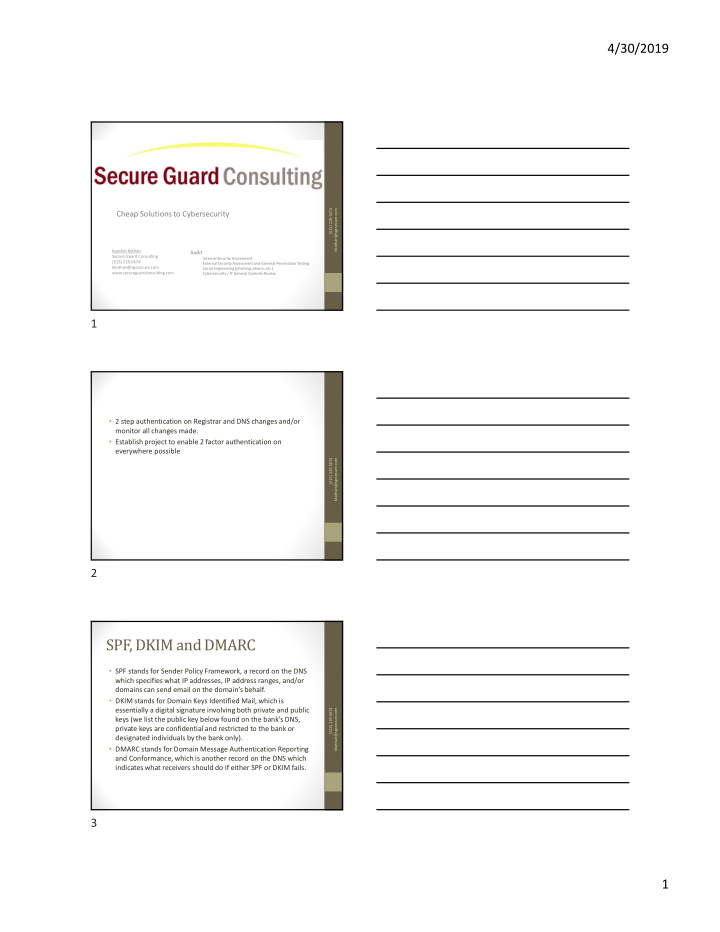



4/30/2019 (515) 229-5674 kkothari@sgcsecure.com Cheap Solutions to Cybersecurity Kaushal Kothari Audit Secure Guard Consulting Internal Security Assessment (515) 229-5674 External Security Assessment and External Penetration Testing kkothari@sgcsecure.com Social Engineering (phishing, phone, etc.) www.secureguardconsulting.com Cybersecurity / IT General Controls Review 1 • 2 step authentication on Registrar and DNS changes and/or monitor all changes made. • Establish project to enable 2 factor authentication on everywhere possible (515) 229-5674 kkothari@sgcsecure.com 2 SPF, DKIM and DMARC • SPF stands for Sender Policy Framework, a record on the DNS which specifies what IP addresses, IP address ranges, and/or domains can send email on the domain’s behalf. • DKIM stands for Domain Keys Identified Mail, which is essentially a digital signature involving both private and public (515) 229-5674 kkothari@sgcsecure.com keys (we list the public key below found on the bank’s DNS, private keys are confidential and restricted to the bank or designated individuals by the bank only). • DMARC stands for Domain Message Authentication Reporting and Conformance, which is another record on the DNS which indicates what receivers should do if either SPF or DKIM fails. 3 1
4/30/2019 SPF • https://www.kitterman.com/spf/validate.html • Gather IP addresses that are used to send email • Web server • Online Banking • Exchange Server or wherever email is hosted • Make a list of your sending and receiving domains • Create your SPF record • Start with v=spf1 (version 1) tag and follow it with the IP addresses that are authorized to send mail. (515) 229-5674 kkothari@sgcsecure.com For example, v=spf1 ip4:1.2.3.4 ip4:2.3.4.5 • If you use a third party to send email on behalf of the domain in question, you must add an “include” statement in your SPF record (e.g., include:thirdparty.com) to designate that third party as a legitimate sender • Once you have added all authorized IP addresses and include statements, end your record with an ~all or -all tag • An ~all tag indicates a soft SPF fail while an -all tag indicates a hard SPF fail. In the eyes of the major mailbox providers ~all and -all will both result in SPF failure. Return Path recommends an -all as it is the most secure record. • SPF records cannot be over 255 characters in length. Here’s an example of what your record might look like: • v=spf1 ip4:1.2.3.4 ip4:2.3.4.5 include:thirdparty.com -all • For your domains that do not send email, the SPF record will exclude any modifier with the exception of -all. Here’s an example record for a non-sending domain: • v=spf1 –all • Publish your SPF to DNS • Test your SPF Record 4 DKIM • https://www.port25.com/dkim-wizard/ • Gather IP addresses that are used to send email • Web server • Online Banking (515) 229-5674 kkothari@sgcsecure.com • Exchange Server or wherever email is hosted • Make a list of your sending and receiving domains • Choose a DKIM selector • Generate a public-private key pair • Store private key securely • Publish the selector and public key by creating the DKIM TXT record • Attach the token to each outgoing email. 5 DMARC • Make a list of your sending and receiving domains • https://mxtoolbox.com/DMARCRecordGenerator.aspx • none policy: You just want to monitor the DMARC results and you do not want to take specific action on all the failing (515) 229-5674 kkothari@sgcsecure.com emails. You can use the “none” policy to start with DMARC and gather all DMARC reports and start analyzing this data. • quarantine policy: You put the emails which fail the checks in quarantine. Most of these emails will end up in the junk folder of the receiver. • reject policy: You can reject all emails that fail the DMARC check. The email receivers should do this ‘on SMTP level’. The emails will bounce directly in the sending process. 6 2
4/30/2019 • Disable web based email. For those who need it, enable 2 factor authentication • PDQ Inventory or some other software inventory management tool • ARP Watch (515) 229-5674 kkothari@sgcsecure.com • Monitor user accounts across all systems • Train Train Train!!!! 7 3
Recommend
More recommend